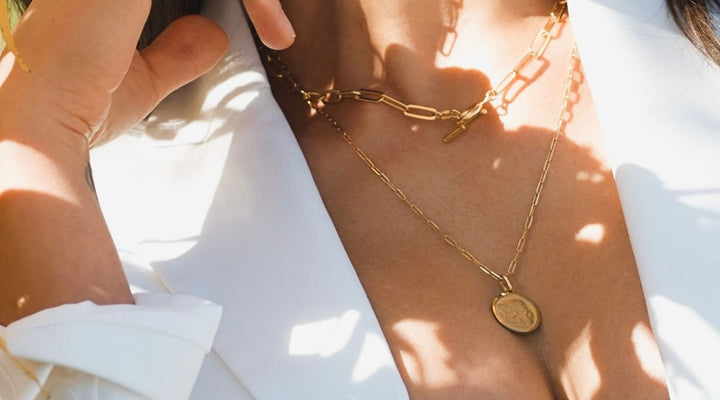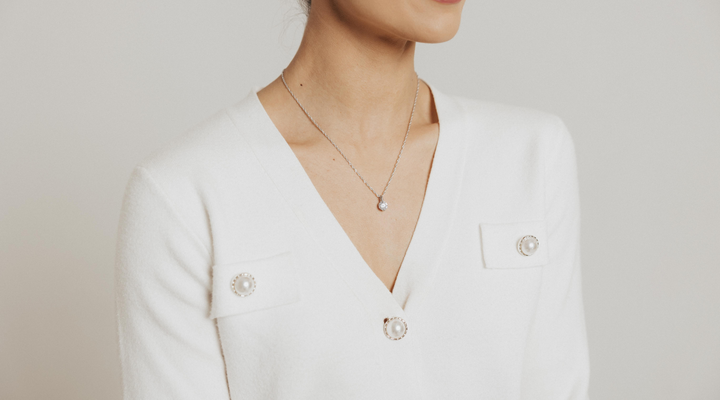Pearls 101: All About The Different Types of Pearls
Posted by Deven Davis on

What Are The Different Types of Pearls: Everything You Need to Know
Natural? Cultured? Freshwater? Saltwater? What do all of these mean in relation to pearls? Here's everything you need to know about the different types of pearls, plus some tips on how to care for your pearl collection.
Keyword(s): Primary KW - types of pearls;Secondary KWs - freshwater pearls, pearl types, best pearls, kinds of pearls, saltwater pearls
Most women dream of having a pearl necklace in their jewelry collection. In fact, many of them have a few different necklaces like this to choose from! Whether you're buying your very first one or you're just interested in getting another, it's worth educating yourself about pearls in the first place.
Such knowledge will help you maintain the quality of your jewelry, and it's helpful when choosing other things like earrings, bracelets, and rings. The main thing to understand is the different types of pearls and proper pearl maintenance.
The following is an explanation of five common pearl types that jewelers carry, and how you can keep them in good condition.
The Main Types of Pearls
You've probably noticed that pearls have slightly different tones of white and that they come in other colors like pink, grey, and blue, too. If your knowledge doesn't go much further than that, though, you've got your understanding of the types of pearls all wrong.
Here's a better understanding of what really differentiates one kind of pearl from another.
Saltwater Pearls, Freshwater Pearls, Cultured Pearls, and South Sea Shell Pearls
Saltwater and freshwater pearls are natural pearls, formed in a body of water without any human intervention. Those that occur in the sea are saltwater and those in a pond, river, or lake are freshwater.
Cultured pearls, on the other hand, are made by human intervention. These start out as a tissue that is input into a mollusk, which is then placed in a controlled body of water until the pearl is ready. Farmers can do this process in both freshwater and saltwater.
Since it's rare to come across a natural pearl, many pearls on the market are cultured. This allows jewelers to keep up with the demand and create beautiful pieces on a consistent basis.
Whether a pearl is a naturally-occurring matter in saltwater or freshwater or if it has been cultured, there are still plenty of names to identify each pearl with. A few common names you may see are:
- Akoya Pearls
- South Sea Pearls
- Tahitian Pearls
- Mabe Pearls
Akoyas are fairly small Japanese pearls with an off-white shade or clear white color. South Sea saltwater pearls come from Indonesia, Australia, and the Philippines. They are the biggest of any pearl, and they come in a wide range of colors including white, cream, golden, or even a soft pink.
Tahitian pearls are arguably the most unique. These also have a wide range of colors, but they're much darker than any other pearl. The main colors they're available in are blue, purple, green, and grey - sometimes even in black!
The Mabe pearl, which actually grows in the shells mollusks they form in. This is why Mabe pearls are flat. A flat pearl may not sound like the best thing to make a string necklace out of, but they make beautiful, unique pendants, earrings, and rings!
South Sea Shell Pearls
This pearl bead actually begins as part of the thick "mother of pearl" layer inside of giant shells found in the South Sea.
These giant shells have been sustainably harvested over the last 100 years, but until recently, there wasn't a great way to make use of this thick layer of mother of pearl inside the shells.
The Masami Pearl Company developed a technique for removing the thick layer of mother of pearl, cubing the layer, and then rounding the cubes into pearl beads. The beads are then polished to showcase their innate luster and inspected for quality.
Finally, each shell bead is meticulously hand-shaped, polished, and buffed to perfection by old-world artisans to enhance the beauty of its deep innate luster.
Bonus: Baroque Pearls
Baroque pearls are some of the most fascinating organic gems available on the jewelry market. They are the perfect choice for fashion-forward women who want to show the world just how unique they are.
Unlike traditional (round) pearls, baroque pearls each have their very own shape and size. Their unique shape and size make them an obvious choice for gorgeous pieces meant to fit every style.
But just how valuable are baroque pearls? Well, scarcity is at play here. They are becoming harder and harder to come by - which is driving the prices up on the world market. Prices nearly doubled from 2017 to 2018 with no end in sight.
What Are Baroque Pearls?
There are two main types of peals out there - round and irregular. If a pearl is round, it is considered to be a traditional pearl. As for all the other irregular shaped ones, they are considered baroque. So basically, any irregularly shaped pearl is considered baroque - but the larger sized pearls are the ones driving the prices higher.
See examples here:
Top Care Tips for All Types of Pearls
Whatever kind of pearl you want to buy or however many pieces of pearl jewelry you already have, proper maintenance is what will really make it last. Without this, you can expect to find yourself going to the jewelry store a little more often than you'd like!
Thankfully, maintenance is pretty simple. All it comes down to is being careful and attentive whenever you put your pearls on and put them away.
To get a better understanding of what this entails, follow the three rules below.
Watch out for Sweat and Water
Although pearls are made in water, they don't do well in this substance once the final product is ready. This is because pearls have a top coat on them to maintain their shine and keep the integrity of the color from the time it was purchased.
As such, you shouldn't wear any pearl jewelry if you're planning to workout or be in the sun for a long period of time. Leave these things at home when you're headed to the beach or going on a hike, and definitely don't swim with them, either.
Avoid Scratching
It's pretty easy to notice if the color is fading from one of your pearls. It's not as clear to see if one of the pearls on a whole string of them gets a scratch, though.
To best avoid scratches, always put your pearls back in the box they came from. If you prefer to keep all of your jewelry in one place, then you should set aside a special, soft area for your pearls. Give your necklace its own drawer in a jewelry box or create padded rows for your pearl earrings and rings.
This way, no matter how many accessories you have or how you store them all, your pearls will always be in top condition.
Avoid Tough Chemicals
Some people think the best solution to a pearl scratch or a fading color is to clean it. Be wary of this. The last thing you want to do is make matters worse by applying a tough chemical to your pearls.
If you do feel the need to clean them, gently rub your jewelry with a soft, damp cloth. Don't put any special cleaner on the cloth. For a better clean, take your jewelry to a professional rather than trying to do it yourself.
Expanding Your Pearl Jewelry Collection
Whether you want to get your favorite pearl necklace cleaned or you need a new pearl necklace, you need to find the right jeweler for the job. As far as new pieces of fine jewelry go, you've come to the right place!
Roma Designer Jewelry is proud to offer a wide selection of all types of pearls and other precious materials. Whatever your personal style is, we have something to match.
Click here to browse all of our pearl options.











